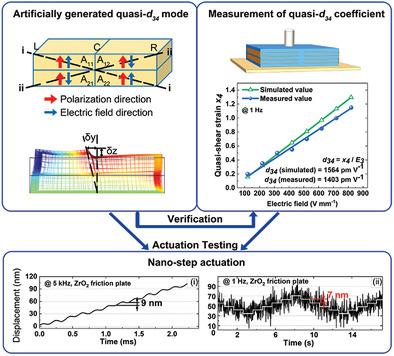Our official English website, www.x-mol.net, welcomes your feedback! (Note: you will need to create a separate account there.)
Designing Ordered Structure with Piezoceramic Actuation Units (OSPAU) for Generating Continual Nanostep Motion.
Advanced Science ( IF 15.1 ) Pub Date : 2020-07-02 , DOI: 10.1002/advs.202001155 Zhanmiao Li 1 , Xiangyu Gao 1 , Jikun Yang 1 , Xudong Xin 1 , Xingyu Yi 1 , Lang Bian 1 , Shuxiang Dong 1, 2
Advanced Science ( IF 15.1 ) Pub Date : 2020-07-02 , DOI: 10.1002/advs.202001155 Zhanmiao Li 1 , Xiangyu Gao 1 , Jikun Yang 1 , Xudong Xin 1 , Xingyu Yi 1 , Lang Bian 1 , Shuxiang Dong 1, 2
Affiliation

|
Continual precision actuations with nanoscale resolution over large ranges have extensive requirements in advanced intelligent manufacturing and precise surgical robots. To produce continual nanostep motion, conventionally, multiple pairs of piezo‐actuators are employed to operate in inchworm principle under complex three‐ or four‐phase timing signal drive. Inspired by the idea of ordered structures with functional units, a much simpler nanostep piezoelectric actuator consisting of (2 × 2) arrayed, cofired multilayer piezoceramic actuation units is developed, which operates in an artificially generated quasi shear mode (AGQSM) that is missing in natural piezoelectric ceramics. Under only one‐phase square‐wave voltage drive, the actuator can produce a stable, continual nanostep motion in two ways at nonresonant frequencies, and the obtained minimum step displacement is as low as 7 nm in open control, indicating its potential application as a precise finger or knife actuator in surgical robots. This work is of great guiding significance for future actuator designs using the methodology of ordered structure with piezoceramic actuation units and AGQSM.
中文翻译:

使用压电陶瓷驱动单元 (OSPAU) 设计有序结构以产生连续的纳步运动。
大范围内纳米级分辨率的连续精密驱动对先进智能制造和精密手术机器人有广泛的要求。为了产生连续的纳步运动,通常采用多对压电执行器在复杂的三相或四相定时信号驱动下按照尺蠖原理进行操作。受功能单元有序结构思想的启发,开发了一种更简单的纳米级压电执行器,由 (2 × 2) 阵列共烧多层压电陶瓷驱动单元组成,该驱动器以人工生成的准剪切模式 (AGQSM) 运行,而这种模式在天然压电陶瓷。仅在单相方波电压驱动下,执行器可以在非谐振频率下以两种方式产生稳定、连续的纳步运动,并且在开式控制中获得的最小步位移低至7 nm,表明其作为驱动器的潜在应用。手术机器人中的精确手指或刀致动器。这项工作对于未来使用压电陶瓷驱动单元有序结构和 AGQSM 的方法设计驱动器具有重要的指导意义。
更新日期:2020-08-19
中文翻译:

使用压电陶瓷驱动单元 (OSPAU) 设计有序结构以产生连续的纳步运动。
大范围内纳米级分辨率的连续精密驱动对先进智能制造和精密手术机器人有广泛的要求。为了产生连续的纳步运动,通常采用多对压电执行器在复杂的三相或四相定时信号驱动下按照尺蠖原理进行操作。受功能单元有序结构思想的启发,开发了一种更简单的纳米级压电执行器,由 (2 × 2) 阵列共烧多层压电陶瓷驱动单元组成,该驱动器以人工生成的准剪切模式 (AGQSM) 运行,而这种模式在天然压电陶瓷。仅在单相方波电压驱动下,执行器可以在非谐振频率下以两种方式产生稳定、连续的纳步运动,并且在开式控制中获得的最小步位移低至7 nm,表明其作为驱动器的潜在应用。手术机器人中的精确手指或刀致动器。这项工作对于未来使用压电陶瓷驱动单元有序结构和 AGQSM 的方法设计驱动器具有重要的指导意义。


























 京公网安备 11010802027423号
京公网安备 11010802027423号